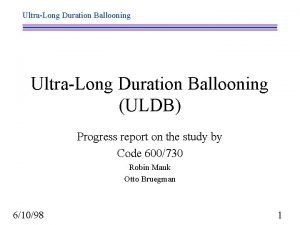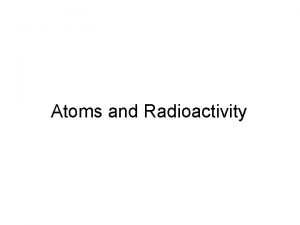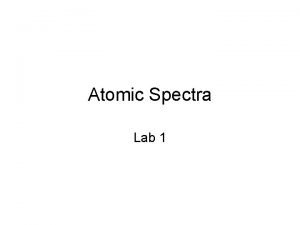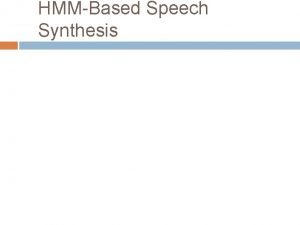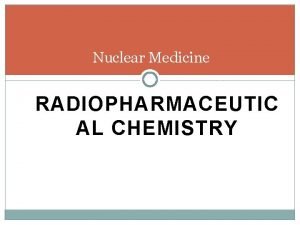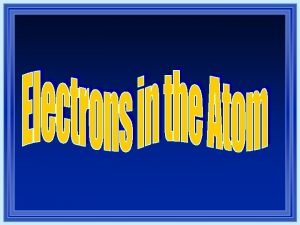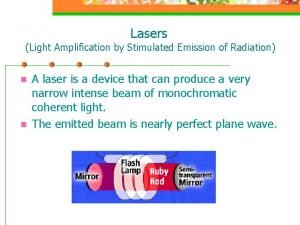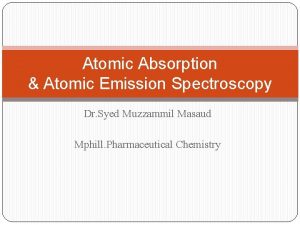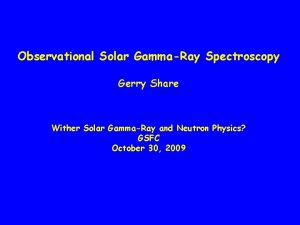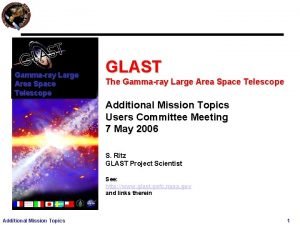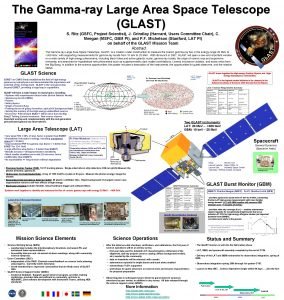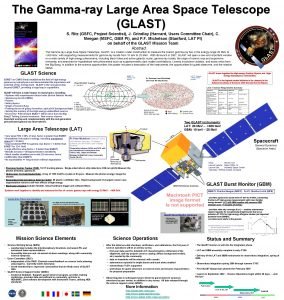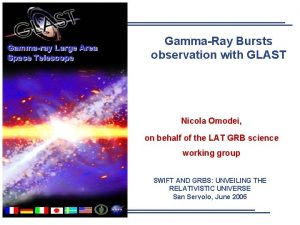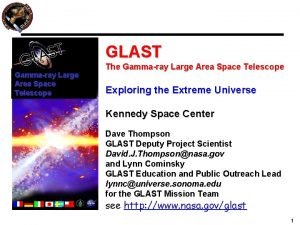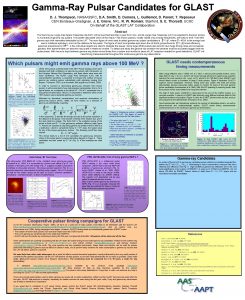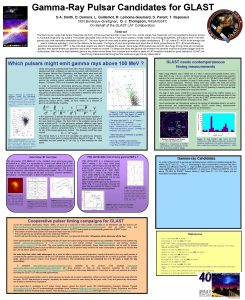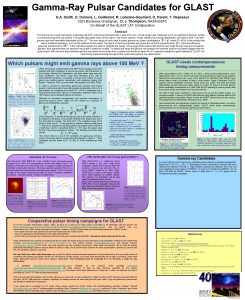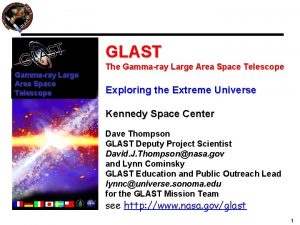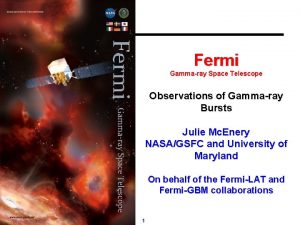Long duration gammaray solar emission during March 78

















- Slides: 17

Long duration gamma-ray solar emission during March 78 th, 2011 observed by Fermi. LAT N. Giglietto (INFN Bari) and A. Allafort (SLAC/KIPAC), M. Brigida(INFN-Bari), F. Longo (INFN-TS), R. J. Murphy (NRL), N. Omodei (Stanford U. ), G. H. Share (NRL), H. Takahashi (Hiroshima U. ) Yasuyuki Tanaka (ISAS/JAXA) on behalf of Fermi/LAT collaboration

Table of Contents 1. Past observations of long-lasting solar gamma-ray emission 2. Fermi-LAT observation of long-lived solar gamma-ray emission following 2011 March 7 flare with multi-wavelength information by RHESSI and other instruments 3. Three possible scenarios 4. Summary EUV (171 A) image by TRACE http: //soi. stanford. edu/results/Sol. Phys 200/Schrijver/TRACEpodarchive. html 2

Current understanding of solar flare Release of magnetic energy via reconnection Radio Hα EUV X-ray (<10 ke. V) X-ray (10 -30 ke. V) X-ray (>30 ke. V) Yokoyama & Shibata 2001 Kane 1974 3

Long-lasting solar gamma-ray emission • In the past decades, only two long-lived (hours long) gamma-ray emissions were observed by EGRET (e. g. Kanbach+93, Ryan 00) Light curve (E>50 Me. V) of 1991 June 11 flare 7 hours Ryan 2000 • It is unclear where, when, how the high-energy (HE) particles responsible for gamma-ray emission are accelerated Kanbach+1993 4

Fermi-LAT detection of quiet-Sun (Abdo et al. 2011, Ap. J in press, astroph/1104. 2093) Count map of the Sun (left) and background (right) Spectrum of disk component • Me. V/Ge. V emission coming from solar disk are due to cosmic-ray cascade in the solar atmosphere • The power-law index is 2. 11 +/- 0. 73 • The flux (E>100 Me. V) is (4. 6 +/- 0. 2 +1. 0/-0. 8)x 10 -7 photons/cm 2/s 5

2011 March 7 flare SDO/304 A • • • GOES class M 3. 7 flare started at 19: 43 UT on Active Region 11164 (North. Western part) RHESSI detected hard X-rays up to 300 ke. V during the impulsive phase The flare ended in hard X-rays around 20: 10 UT 6

Remarkable features of the March 7 flare • • • Following the M 3. 7 flare, large coronal mass ejection (CME) was observed by SOHO/LASCO The velocity is ~2200 km/s, which is the highest since 2005 September (http: //www. spaceweather. com) Neither neutron capture line nor gamma-ray lines was detected by RHESSI during the 7 impulsive phase (Priv. comm. , G. Share and R. Murphy)

Fermi-LAT observation of long-lasting emission Events (100 Me. V-1 Ge. V) within 5 deg Preliminary Exposure • • The Sun was NOT in the Fo. V of Fermi-LAT during the impulsive phase, and entered the Fo. V from 20: 08 UT High-energy photons (100 Me. V – 1 Ge. V) were significantly detected in the subsequent 5 periods, suggesting that the high-energy (HE) radiation lasts for ~12 hours 8

Multi-wavelength light curve Preliminary • Following M 3. 7 flare at ~20 UT on March 7, Fermi-LAT detected long-lasting HE emission over ~12 hours • LAT flux showed clear rising profile • No corresponding long-lasting enhancements were seen in hard X-ray (RHESSI), soft X-ray (GOES), and radio (Nobeyama) bands • GOES proton monitor at 1 AU detected solar energetic protons above 50 Me. V, suggesting that CME-driven shock indeed accelerated protons 9

Gamma-ray emission region Solar disk SDO/193 A image • • • Sigificance map (so-called TS map) was produced for the LAT data accumulated during the whole duration Green lines show the 1 sigma, 2 sigma, 3 sigma contours The LAT HE photons came from the North-western part of the Sun, from where M 3. 7 flare was emitted (active region 11164) 10

LAT spectrum • • The LAT data are accumulated for the whole flare duration The LAT spectrum showed clear turn over around 200 Me. V Pion decay model of proton index s=4. 5 (Murphy et al. 1987) well represents the LAT spectrum 11 Broken power-law model also provides reasonable likelihood values

Possible scenario 1 • Trap and precipitation of HE protons produced during the impulsive phase via magnetic reconnection (e. g. , Kanbach et al. 1993) ² Quantitative estimation of total number of accelerated protons during the impulsive phase as well as the LAT emission is needed ² RHESSI detected no evidence of gamma-ray line emissions during the impulsive phase. From the RHESSI data, upper limit of the total number of accelerated protons produced during the impulsive phase is being estimated ² Comparison with the total number of protons responsible for the LAT emission would provide constraints on this scenario Yokoyama & Shibata 2001 12

Possible scenario 2 • Precipitation of HE protons accelerated stochastically within the loop (2 nd order Fermi) (e. g. , Ryan & Lee 1991) ² Application of the observed time scales ² Unreasonably large loop size (c. f. solar radius: ~10^11 cm) ² Assuming the loop size of 10^5 km and Alfven velocity of 1000 km/s, MHD turbulence is maintained only for ~100 s, unless there is an energizing process in flaring loops ² How the MHD turbulence is maintained? (Is it possible to explain the long-lived signature? ) SOHO EUV image © NASA 13

Possible scenario 3 • Return of protons accelerated by CME-driven shock (1 st order Fermi) (Murphy et al. 1987, Cliver et al. 1993) ² Maximum energy of protons ² Acceleration time of 1 Ge. V proton ² The fast CME-driven shock can easily and immediately accelerate protons up to >300 Me. V ² Note that the CME-driven shock proceeds away from the Sun ² Is it possible to explain the LAT rising profile? Cliver+1993 14

Summary • Fermi-LAT detected the longest HE emission from the Sun following the 2011 March 7 flare. The duration was ~12 hours. • The LAT emission came from the North-West part of the Sun, from where the M 3. 7 flare is emitted • The LAT spectrum showed clear turnover around 200 Me. V, suggesting that pion decay is promising • The March 7 flare is associated with a fast CME of 2200 km/s • We considered three possible scenarios which might explain the longlived LAT emission • Further quantitative discussion is ongoing, and paper is now being prepared 15

Extra slides 16

Possible scenarios • Trap and precipitation of HE protons produced during the impulsive phase via magnetic reconnection (e. g. , Kanbach et al. 1993) ² RHESSI detected no evidence of gamma-ray line emissions during the impulsive phase ² Quantitative estimation of total number of accelerated protons from RHESSI upper limit of gamma-ray lines is now ongoing • Precipitation of HE protons accelerated stochastically (2 nd order Fermi) within the loop (e. g. , Ryan & Lee 1991) ² Assuming the loop size of 10^5 km and Alfven velocity of 1000 km/s, MHD turbulence maintained only for ~100 s, unless there is an energizing process in flaring loops ² Is it possible to explain the long-lived signature? 17
 March march dabrowski
March march dabrowski Once upon a time there lived a fox
Once upon a time there lived a fox Long and short
Long and short Ultra long duration balloon
Ultra long duration balloon Nationalismo sa china
Nationalismo sa china Ccp
Ccp Wholesale solar cell battery
Wholesale solar cell battery Inexhaustible source of energy
Inexhaustible source of energy Gamma emission equation
Gamma emission equation Emission line
Emission line Zero emission neighbourhoods
Zero emission neighbourhoods Transition and emission probability
Transition and emission probability Positron emission tomography
Positron emission tomography Why are atomic emission spectra discontinuous
Why are atomic emission spectra discontinuous Light amplification by stimulated emission of radiation
Light amplification by stimulated emission of radiation Cispr 22 radiated emission limits
Cispr 22 radiated emission limits Half life formula
Half life formula Difference between absorption and emission spectrum
Difference between absorption and emission spectrum



